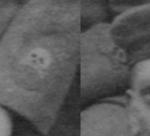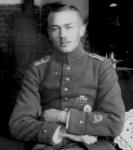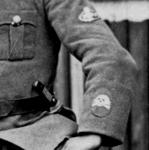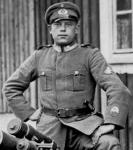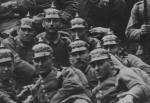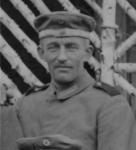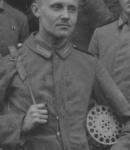
Thomas W
For Deletion-
Posts
788 -
Joined
-
Last visited
-
Days Won
3
Content Type
Profiles
Forums
Blogs
Gallery
Events
Store
Everything posted by Thomas W
-
And, finally, here's another postwar image. I spotted this guy in a postcard of a crowd standing in front of the Vorw?rts newspaper building in Berlin after it was stormed on January 11, 1919. Two flamethrower squads of Freikorps Potsdam took part in the assault. This man wears full wartime flamethrower-pioneer uniform, including black shoulder straps, Garde Litzen, and Totenkopf sleeve badge. He was almost certainly a member of the Freikorps Potsdam flamethrower squads. From what I gather, most postwar flamethrower squads were made up of regular infantry or pioneers, with one or two former members of the Garde-Reserve-Pionier-Regiment as trainers and overseers.
-
Here's a close-up of the sleeve badges. Note that the skull on the right is very dark and appears to be mounted directly on the sleeve of the pioneer, instead of on an oval cloth backing as is generally seen. The badge could be cloth or metal. Compare the color to the standard-issue badge on the left:
-
Robin, although my scanner is dead, I went through my old scans and found this image, which I included in my book German Flamethrower Pioneers of World War I. It's a 1919 photo of an Oberleutnant with numbers on his shoulder straps, which I was unable to identify. They're rounded digits, either "3," "5," or "9." Although an officer, he wears the wartime flamethrower-pioneer death's head in the enlisted pattern, cut from gray cloth instead of embroidered in silver bullion. You can even see the white teeth in this photo. The handwritten message on the back of the card identifies him as a "Noske-Gardist" or government-loyal soldier in a Minenwerfer unit. By the way, my new book, Flamethrower Troops of World War I: The Axis and Allied Powers, will cover all flamethrower units of all the combatants in the war. It should be published sometime this year, if I'm lucky!
-
Here's a close-up of the sleeve badge, which is a white, generic skull that wasn't covered by the Order of July 28, 1916. The official letter from the Crown Prince authorized the flamethrower troops to wear the badge only for the duration of the war. In the postwar period, the 1st Company of (Preussisches) Pionier-Bataillon Nr. 3 was the Traditionstruppe of the Garde-Pionier-Bataillon and the Garde-Reserve-Pionier-Regiment. A Generalmajor Haenichen, president of the German Pioneers Association, tried to have the 1st Company awarded a death's head sleeve badge, but he was turned down by the Reichswehr defense minister without explanation.
-
Well, my scanner just died. Excellent. I was going to post a photo I have of a wartime flamethrower pioneer wearing what looks like an almost-black death's head sleeve badge, but now I can't, and tomorrow the photo is going to the publisher of my next book. Crud. At any rate, if the skull badge is real, it's probably a postwar device. Sorry about the problem. Don't buy Canon scanners.
-
The War Ministry ordered the establishment of the II. Garde-Pionier-Ersatz-Batallion on February 26, 1916, as the official replacement battalion for flamethrower pioneers. It was created on March 1 by expanding the Replacement Company of the III. Garde-Pionier-Bataillon into four Replacement Companies and one Garrison Company. Prior to the establishment of the II. Garde-Pionier-Ersatz-Bataillon replacements for the III. and IV. Garde-Pionier-Bataillone came from the Garde-Pionier-Ersatz-Bataillon, which was already providing replacements for the Garde-Pionier-Bataillon and other formations, including trench-mortar units. The two flamethrower battalions were taking too many men, so the War Ministry established the II. Garde-Pionier-Ersatz-Bataillon specifically to provide replacement flamethrower pioneers.
-
You're probably right that the overall numbers were too small to make much of a difference. The definitive answer would be found if somebody determined the total number of young, fit, smart men available to the German army and figured out how many went to the assault battalions. I'm guessing it was a single-digit percentage. I can only talk about the flamethrower formations, since that's my field of interest. In early February of 1916 the OHL expanded each field company of the III. Garde-Pionier-Battalion from 139 men to 200 men. To do so pioneers were brought in from the battalion recruit depot and the Garde-Pionier-Ersatz-Bataillon, and 360 infantrymen were handpicked from various regiments. On September 26, 1916, the 11th and 12th Companies were added to the Garde-Reserve-Pionier-Regiment, using officers and men from the recruit depot and the II. Garde-Pionier-Ersatz-Bataillon, the official replacement battalion for the flamethrower regiment. In addition the Fifth Army High Command transferred 500 young infantrymen into the regiment. I have several photos of men from the II. Garde-Pionier-Ersatz-Bataillon, and they range in age from about 17 all the way up to mid-40s. I've read that to be eligible for the assault battalions there was a cutoff age of 25 (or 27), but that was clearly not the case for flamethrower troops. The older men were almost certainly firefighters, who tend to be very strong, fit men even well into middle age. For many years a firefighter in his 50s won the annual race up the stairs to the top of the Empire State Building in New York. Here's a flamethrower pioneer attached to an assault battalion in 1917. All of the flamethrower pioneers attached to assault battalions were combat troops and not workshop personnel. This guy is no kid. I have trouble telling how old he is, but I'd say late thirties at least.
-
Just to clarify: The flamethrower pioneers of Sturmbataillon Nr. 5 (Rohr) wore Guard Pioneer uniforms with a red "5" on the shoulder straps. I have a photo that shows this. I can't post it because it's in my new book Flamethrower Troops of World War I: The Central and Allied Powers, which will be published by Schiffer later this year. The flamethrower pioneers of Sturmbataillon Nr. 5 (Rohr) did wear the death's head sleeve badge, but directly below the left elbow, not on or above the left cuff as prescribed for the men of the Garde-Reserve-Pionier-Regiment. After February of 1916 Rohr's flamethrower pioneers came directly from the II. Garde-Pionier-Ersatz-Battalion. They served with Rohr an unspecified time and then many were transferred into the G-R-P-R. When they joined the G-R-P-R, they moved their death's head sleeve badge into the lower position, on or directly above the cuff. Here's a flamethrower pioneer of Sturmbataillon Nr. 14. The photo on the left was taken May 19, 1918, and the one on the right August 9, 1918. You can see that in May he still wore his sleeve badge in the upper position, as he had recently been transferred out of Rohr's battalion. By August he had moved the badge down to the cuff of his Bluse.
-
Chip: The first two assault companies of Sturmabteilung/Sturmbataillon Rohr were formed from men of Pionier-Ersatz-Bataillon Nr. 7; the remaining assault companies and the replacements for all came from Pionier-Ersatz-Bataillon Nr. 35, which also provided replacements for one of the poison-gas regiments, No. 35. Since we're all Rohr all the time, I just bought a photo of a member of the howitzer battery of Sturmbataillon Nr. 5 (Rohr), name and date unknown. He wears red shoulder straps with a yellow exploding shell and a "5," and he has a camouflaged helmet.
-
Yup, he left out a few important details in his book. Like the existence of the IV. Garde-Pionier-Bataillon, for example, and the relationship of his regiment with Sturmbataillon Nr. 5 (Rohr). I was only recently able to confirm that the flamethrower pioneers of Sturmbataillon Nr. 5 (Rohr) came directly from the Ersatz-Kompagnie of the III. Garde-Pionier-Bataillon and later the II. Garde-Pionier-Ersatz-Bataillon. After they served with Rohr's unit, they transferred into other units, such as the Garde-Reserve-Pionier-Regiment. They went to from Rohr's unit to Reddemann's, but not the other way around. (In the beginning some may also have come from Pionier-Ersatz-Bataillon Nr. 36, which supplied replacements for the gas regiments. But by early 1916 they were coming from the Ersatz-Kompagnie of the III. Garde-Pionier-Bataillon.) Rohr's flametnhrower pioneers also wore the death's head sleeve badge directly below the left elbow to distinguish them from Reddemann's pioneers. I have two photos that show a guy as a member of the flamethrower platoon of Sturmbataillon Nr. 14. In one, taken on May 19, 1918, he wears his sleeve badge under his left elbow, since he just transferred out of Rohr's unit. In the other photo, taken on August 9, 1918, he's moved his death's head badge down onto the cuff of his Bluse. I haven't been able to find a written order that differentiates the sleeve badges of Rohr and Reddemann's men, but there's no doubt that Rohr's men wore their badge below the elbow instead of on or above the cuff. Although Reddemann never mentions Rohr at all, it's clear that Rohr had a very exalted place in the German army heirarchy. Only a few months ago I discovered that Rohr's flamethrower pioneers wore Garde-Pionier uniforms, but with a red "5" on the shoulder straps, like the rest of the men in the battalion. I found a crystal-clear photo, which I'm including in my upcoming flamethrower book. Reddemann's book is a vital primary source. Even so, it's very flawed. In his book he says that three companies of flamethrower pioneers attacked the Russians at Skrobova on November 9, 1916, but in Das Ehrenbuch der Deutschen Pioniere he says it was an entire battalion. He also screws up the number of small flamethrowers used. He says in Das Ehrenbuch it was 130 Kleif, but if you add up the number of flamethrower shock troops (12 x 12 = 144), plus the number of flame shock troops in reserve (4 x 12 = 48), plus the number of Kleif squads put in the interval between the attacking flame shock troops and the infantry shock troops (2 x 12 = 24), you get a total of 216 Kleif, the number of weapons that armed an entire battalion. I think he was just sloppy. He was a star and knew it, so he didn't take the time to be careful in his memoirs, and he didn't like to share the spotlight with anybody, like Rohr.
-
Here's another cartoon with the same tank-with-a-hose rendering. The two soldiers on either side are French, and the one in the middle is German. The caption leaves no doubt that the weapon a flamethrower, since the term "P?troleur" was the nickname of French flamethrower sappers. The translation is, "The flamethrower operator: 'I say to you, my captain, this good fellow, thinking that it's time to prepare the lamps, has brought his oil.'" http://www.greatwardifferent.com/Great_War...throwers_01.htm
-
This cartoon is titled "Pi?t? Boche: L' Angelus, imit? de Millet" (Kraut piety: L'Angelus, imitation of Millet). It appeared on the cover of the December 10, 1916 edition of the magazine P?le-M?le. It's a parody of the painting L' Angelus, by Jean-Fran?ois Millet, which depicts French peasants pausing in their harvest to pray. This cartoon is an attack on the Germans, who are piously pausing to pray in the midst of their "harvest" of mayhem and destruction created with gas/flamethrowers. For most of the war the average non-military person never saw detailed photos or illustrations of flamethrowers, gas cylinders, or gas projectors. Rabiel's rendering of a tank with a hose and a nozzle is very common among French cartoonists. I've seen two other cartoons that show this, and they're meant to indicate both gas and flame. In 1915 the British captured the German document Note 32, "Arms Available to the Pioneers for Close Combat: Projectors for Flame and Smoke-producing Liquid," dated October 16, 1914. It described the use of the kleine Flammenwerfer (Kleif) M.1912, the first portable German flamethrower. Note 32 was published in several French and British newspapers and used in anti-German propaganda leaflets. From mid-1915 to early 1916 the Germans and possibly the Austrians used Kleif M.1912 to spray poison gas on the eastern front. These attacks received somewhat extensive coverage in contemporary newspapers and helped blur the line between gas and flame in the mind of the average person. The weapons in Rabiel's cartoon are not meant to show a particular model of flamethrower or gas projector but are instead a sort of generic representation of Hun "frightfulness." Here's a Kleif M.1912, by the way, from a Russian newspaper. It was worn by one man but operated by a squad of two. The "carrier" aimed the lance while the "assistant" stood beside him, opened the round oil-pressurization valve on the side of the tank, and then fired the weapon by opening the protruding block valve at the base of the telescoping lance, which was connected to the oil tank by means of a swiveling universal joint.
-
In my photos of two sappers, one has metals badges and numerals on his shoulder boards, and the other painted badges and numerals. Can anybody explain why the difference? Thanks. Tom W.
-
Hi Rick: The back of the postcard identified the guy as Reddemann, so I don't know what to say. I no longer have the original image, so I can't provide a scan. Facially he's identical to the other shots, except for the mustache. The ear, glasses, chin, nose, and shape of the mouth are the same. If you read Reddemann's memoirs, he has a propensity to, um... make things up. For example, he claims universal success in operations that the other side says were failures. He also takes credit for flamethrowers developed by others and operations carried out by Willy Rohr. The #14 photo was taken on Deutscher Pionier und Verkehrstruppen-Tag in Munich, July 17, 1925. Reddemann is wearing a Prussian fire-chief's walking-out uniform instead of a Garde-Pionier uniform, which is odd. When I was researching my book on German flamethrower pioneers, I hired a German geneologist who traced people she swore were descendents of Reddemann. They all denied they were, and they refused contact with me. I wonder if he was some kind of nutter who--along with his tendency to lie about his achievements--wore inappropriate uniforms and medals he wasn't awarded? Or you could be right, and the guy in the first and last photos isn't Reddemann at all. Strange to find two German firemen--or maybe three--who all have exactly the same face and build and are the same age...


